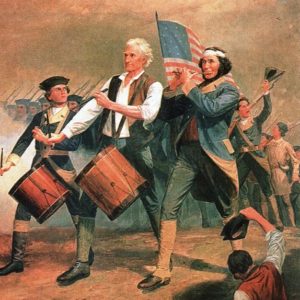It seemed sudden — even though it had been a long time coming.
Friends divided over questions with few clear answers. As a plague engulfed the continent, well-intentioned individuals had to choose between red and blue.
Some recognized threats to religious liberty. Others watched their livelihoods fall victim to what they viewed as mass hysteria.
Some thought that the government on which they relied to protect them lacked the backbone to perform this basic task. Others lost faith in longstanding promises to protect their individual rights and ensure their equality under the law.
Welcome to 2020. And welcome back to 1776.
This Fourth of July, it’s more important than ever to appreciate what America’s revolutionary past has to teach us in the present.
Back then, war pitted Redcoats and their homegrown Loyalist allies against George Washington’s men in blue. The plague was smallpox. In the aftermath of the 1754-63 French and Indian War, churches feared falling under an English bishop’s command.
Taxes, imposed without Americans’ consent, sparked boycotts and economic misery. When soldiers fired on a Boston mob, people wondered if men in uniform, previously seen as protectors, were actually the enemy.
Tensions spiked after the 1773 Boston Tea Party.
Rather than prosecuting individuals for tossing taxed tea into Griffin’s Wharf, the British employed group punishment by closing Boston Harbor, hobbling the Massachusetts legislature, banning town meetings, and curtailing jury trials. In 1775, Redcoats marched through Lexington to Concord to seize colonists’ arms and ammunition, triggering a war.
American revolutionaries embraced the philosophy of John Locke, who justified England’s successful Glorious Revolution of 1688 by explaining that governments existed because “no one ought to harm another in his life, health, liberty, or possessions.”
Sam Adams reminded colonists of their “right to life” as well as “liberty” and “property.”
George Mason insisted that no person had the right to deprive another of “the enjoyment of life and liberty, with the means of acquiring and possessing property, and pursuing and obtaining happiness and safety.”
Then Thomas Jefferson produced the Declaration of Independence.
“We hold these truths to be self-evident,” read the text adopted by the Continental Congress, “that all men are created equal; that they are endowed by their creator with certain inalienable rights; that among these are life, liberty, and the pursuit of happiness; that to secure these rights, governments are instituted among men, deriving their just powers from the consent of the governed.”
Some assert that “all men” included only white men, but Jefferson’s draft makes clear that he referred to all mankind. He rebuked the “horrors” of the slave trade, which violated “the most sacred rights of life and liberty” of a “distant people” by “carrying them into slavery.”
The Declaration of Independence codifies the ideals on which our nation was established. It lays the foundation for the U.S. Constitution and amendments banning slavery and advancing equal rights. It lights the path by which we, as modern-day patriots, can bring positive change through our democratic process.
In 2020, we need more of the Spirit of ’76.

